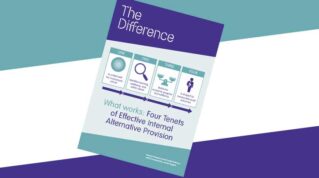The country’s biggest academy trusts now extract £200 million from their schools’ budgets to fund growing central teams.
Analysis by Schools Week of the 30 largest trusts found the average amount top-sliced has risen by 50 per cent per pupil since 2021. This dwarfs the 16 per cent rise in school funding over the same period.
Trusts say they are centralising more services because it saves money overall and frees up staff time to focus on the classroom.
‘MATs absorbing more funding’
But Daniel Kebede, the general secretary of the National Education Union, claimed academy freedoms led to “an unbalanced system where MAT officialdom and booming CEO pay is absorbing an ever-greater proportion of funding, while teachers and support staff suffer.
“We also need much greater transparency in MAT finances to ensure that school funding is going where it should be: frontline teaching and learning.”

Schools Week analysis shows amounts charged to fund central teams in the biggest trusts rose to just over £198 million in 2023-24.
This compares to £118 million three years earlier.
Costs rose per pupil too, from £247.60 to £362.78.
Trusts usually fund these teams by collecting a fixed percentage of each school’s budget, or general annual grant (GAG) funding.
Large trusts now top slice on average 5.5 per cent, a study by the Kreston group of accountancy firms found, compared with 8.8 per in smaller trusts.
Of the trusts we analysed, five more than doubled their central service charges per pupil. The biggest rise was at the Bishop Bewick Catholic Education Trust (176 per cent).
‘Charges lead to cost savings’
The trust said its central team grew to accommodate a “rapid growth” from three to 39 schools in two years. Despite this, its top slice was still below the 5 per cent it “expected to use and is very cost effective”.
Cost per pupil rose 151 per cent for central team services at the Co-operative Academies Trust.
Dr Chris Tomlinson, its chief executive, said it had created a “comprehensive suite of new central services” – including IT, governance and school improvement – that provided “many cost savings” to its academies.
As well as saving staff time, Tomlinson estimated the trust’s primaries saved up to £50,000 as a result.
Bishop Wilkinson Catholic Education Trust in the north east, which grew from six to 47 schools, had a 122 per cent rise. It has charged schools a rate of 4.5 per cent since 2022.
‘Top slice less than LAs’
Nick Hurn, its chief executive, also said schools previously paid an “average of between 7 to 12 per cent of their income to local authorities and private companies”.
Lift Schools, which spent £18.5 million on its central team last year, charged the most, with per pupil charges more than doubling since 2020-21.
However, the trust said its “actual” cost was £17.5 million, as its 57 schools had an overall net deficit of £1.1 million in the financial year.
A trust spokesperson said the rise was down to changes in how it accounted for central team charges to be “more transparent about the actual cost” to academies.
Unsurprisingly, United Learning, England’s biggest MAT with 90 schools, was second (£16 million). But its per pupil charges have remained static.
Sir Jon Coles, its chief executive, said he aimed “to reduce the cost of our central services per pupil” each year.
It now spent less in real terms per pupil than four years ago, but spent “substantially more per pupil at the centre on school improvement, subject specialist support, curriculum and assessment”.
The impact of growth
Lift said its budgets had also been “repurposed to focus much more on frontline education”.
Spend on education teams, data, AI and apprenticeship programmes all rose.
New regional education directors leading improvement work also helped to boost outcomes. Ninety-five per cent of Lift schools were now ‘good’ or better, up from 75 per cent in 2021.
Coles said growth at United had been a “key enabler” to increase spend..
“Our key purpose in taking on more schools has been to improve educational opportunity for more children, but we have also made sure that our growth always benefits our existing schools through enabling us to improve educational support while reducing cost.”
The Kreston report shows the average size of a MAT has increased to 11.7 schools (11.3 per cent) by August. This represents double the growth in 2023 and the highest rate of growth since 2018.
More trusts centralising
The Confederation of School Trusts’ 2024 national survey showed more than 80 per cent of academy chains “primarily direct centrally” finances and estates services.
More than 60 per cent also directed school improvement and procurement from the centre.
Kreston revealed 79 per cent of MATs (61 per cent last year) were now “fully centralised”, with “all functions” – such as finance, estates, HR, IT and procurement – centralised across all their schools.

It said the findings showed “centralisation is clearly recognised as the best way for MATs to structure their internal functions”.
Leora Cruddas, the trusts’ chief executive, said there was “often a misconception with shared services that money is somehow being taken out of school budgets”.
“The reality is that trusts are providing help with HR or estates or finance that all schools need and will have to pay for, it is just accounted for more transparently in trusts.”
While it is possible to compare change over time at individual trusts, leaders pointed out making comparisons was difficult because they all vared in what they categorised as “central team”.
More leaders on big bucks
The Kreston study suggests “larger trusts are financially far more efficient” in the “often-substantial cost area” of central teams.
It is difficult to work out from public data how many central staff member trusts employ.
But Kreston’s findings suggest large MATs spend £143 per pupil on key management personnel, described in annual accounts are those “with a broadly strategic role at trust level”.
This compares with £1,147 in primary MATs and £479 in small multi-academy trusts.
However, one chief executive said some trusts kept their central charges “artificially low” by asking schools to pay extra for services not covered by top-slicing.
Pay is another proxy for central teams. Pay scales show maintained school heads can earn up to £131,000, although this rises to £140,000 in London.
Trusts can set their own pay. Across the 31 biggest MATs, 183 staff were paid more than £130,000, up from 98 in 2020-21.
Harris Federation led the field last year (25). Of these, about two-thirds are understood to be principals, executive principals and regional directors based in schools and not funded by central service charges.
Accounts published last week show Dan Moynihan, the trust’s chief executive, has become the first academy boss to earn more than £500,000 (his salary rose to at least £515,000).
‘It might not be the most efficient way’
But Harris appears to be an outlier, with five of the big trusts having one leader on more than £130,000. Three others had none.
The Oxford Diocesan Schools Trust (ODST) and the Diocese of Norwich Education Academies Trust (DNEAT) are two of them.
Anne Dellar, the chief executive of the ODST, said 21 people were employed solely in the central team.
“We’re a very delegated trust,” she said. “We believe helping local leaders make decisions for their cohorts is the best way to deliver excellence.”
She conceded it might “not be the most efficient way of doing it but people who know children and their needs, in our view, should be making decisions about curriculum design and all that”.
At DNEAT, which runs 41 primaries and one secondary, central charges have remained broadly in line with 2020-21 levels, rising 7 per cent per pupil.
Oliver Burwood, its chief executive, said it was “particularly challenging” to run very small primary schools. “Whatever we take to the centre, for whatever purpose, isn’t going to the school.”
‘No best way’
Toby Greany, professor of education at the University of Nottingham, said decisions on how far to integrate functions across a trust involved “a set of tricky choices, not least given the implications for academy budgets which must fund any central team costs”.
Government-commissioned research he conducted found trusts tended to appoint central teams and integrate back office and school improvement functions as they grew.
But he said there was no “one best way” to develop a trust. “In times of tight budgets, MAT leaders must think creatively to ensure that every penny supports the ‘constant dance’ of collective improvement.”
As well as top-slicing, trusts can fund their central services by GAG pooling – collecting all their schools’ budgets first before dishing out funds based on their own formula.
Our analysis did not include the four big MATs that did this, as they do not provide central service figures.
According to Kreston, 37 per cent of MATs do this or pool reserves. A further quarter are considering it as it gave them “more flexibility over how they achieve their objectives”.
Mark Greatrex, who leads the 12-school Bellevue Place Education Trust, said such rises in central team costs will have resulted in “squeezed” school budgets – something “MATs must be accountable for”.
But he said: “Central teams are an important resource to support school improvement. The pressure we feel through governance, external audits, internal audits and SMRA visits, is to look for efficiencies in our buying power and better use of systems, [and] rightly so.”
















This is a really interesting analysis of a very tricky area for trusts and others in the system to be navigating. Finding the right balance between central and delegated functions is difficult and the trust system is still developing so rapidly. It is right that we scrutinise what is done centrally and the cost of it and there will be examples of poor practice. My experience working with a number of trusts over the last few years is that growth and expenditure in the central team was solely led by the strategic direction of the trust and a desire to meet their pupils and students needs above all else. It is no perfect, but neither is how local authorities agree what services they provide and at what cost to maintained schools. I do agree that more and better data from both trusts and LAs would help with scrutiny and comparison. There is plenty the sector has to do to provide information to the DfE that feels pointless that could be replaced by meaningful data collection on this.
So LA teams have been cleared out to be replaced by more, but smaller admin structures.
LAs used to provide significant cost savings by central purchasing, appeals and advisory services.
Have MATs just become micro LAs with very highly chief education officers.
To get insight follow the money!!
Great article btw